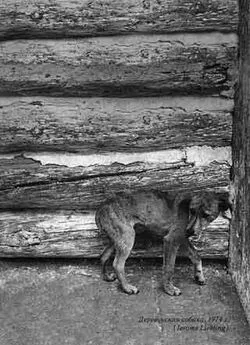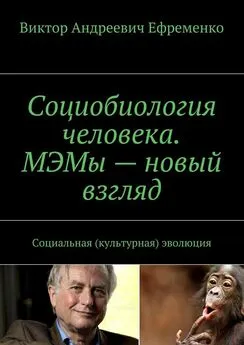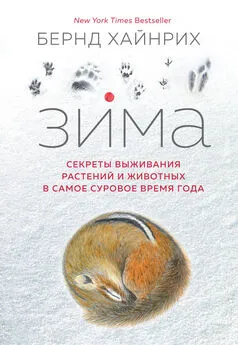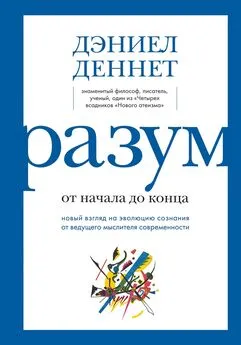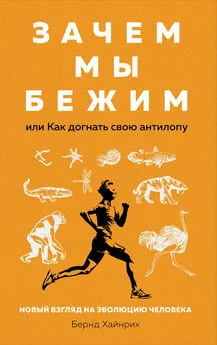Берндт Хайнрих - Зачем мы бежим, или Как догнать свою антилопу [Новый взгляд на эволюцию человека] [litres]
- Название:Зачем мы бежим, или Как догнать свою антилопу [Новый взгляд на эволюцию человека] [litres]
- Автор:
- Жанр:
- Издательство:Литагент Аттикус
- Год:2020
- Город:Москва
- ISBN:978-5-389-18474-9
- Рейтинг:
- Избранное:Добавить в избранное
-
Отзывы:
-
Ваша оценка:
Берндт Хайнрих - Зачем мы бежим, или Как догнать свою антилопу [Новый взгляд на эволюцию человека] [litres] краткое содержание
«Я утверждаю, что наши способность и страсть к бегу – это наше древнее наследие, сохранившиеся навыки выносливых хищников. Хотя в современном представителе нашего вида они могут быть замаскированы, наш организм все еще готов бегать и/или преследовать воображаемых антилоп. Мы не всегда видим их в действительности, но наше воображение побуждает нас заглядывать далеко за пределы горизонта. Книга служит напоминанием о том, что ключ к пониманию наших эволюционных адаптаций – тех, что делают нас уникальными, – лежит в наблюдении за другими животными и уроках, которые мы из этого извлекаем». (Бернд Хайнрих)
Зачем мы бежим, или Как догнать свою антилопу [Новый взгляд на эволюцию человека] [litres] - читать онлайн бесплатно ознакомительный отрывок
Интервал:
Закладка:
Schmidt-Nielsen K., Schmidt-Nielsen B., Houpt T. R., Jarnum S. A. The question of water storage in the stomach of the camel // Mammalia. 1956. 20. P. 11–15.
Schmidt-Nielsen K., Schmidt-Nielsen B., Houpt T. R., Jarnum S. A. Water balance of the camel // American Journal of Physiology. 1956. 185. P. 185–194.
Billings D. Aerobic efficiency in ultrarunners // Ultrarunning. 1984. November. P. 24, 25.
Davies C. T. M. Physiology of ultra-long distance running // Medicine and Sport. 1981. 13. P. 53–63.
Taigen T. L., Wells K. D. Energetics of vocalization by an anuran amphibian (Hyla versicolor) // Journal of Comparative Physiology. 1985. 155. P. 163–170.
Taigen T. L., Wells K. D., Marsh R. L. The enzymatic basis of high metabolic rates in calling frogs // Physiological Zoology. 1985. 58. P. 719–726.
Wells K. D., Taigen T. L. The effect of social interactions on calling energetics in the gray treefrog ( Hyla versicolor ) // Behavioral Ecology and Sociobiology. 1986. 19. P. 9–18.
Alexander R. M. Elastic energy stores in running vertebrates. American Zoology. 1984. 24. P. 85–94.
Alexander R. M. Elastic Mechanisms in Animal Movement. Cambridge, U.K.: Cambridge University Press, 1988.
Darwin C. R. On the Origin of Species by Means of Natural Selection, or The Preservation of Favored Races in the Struggle for Life. L.: John Murray, 1859.
Gordon D. G. The Compleat Cockroach: A Comprehensive Guide to the Most Despised (and Least Understood) Creatures on Earth. Berkeley, Calif.: Ten Speed Press, 1996.
Ker R. F., Bennett M. B., Bibby S. R., Kester R. C., Alexander R. M. The spring in the arch of the human foot // Nature. 1987. 325. P. 147–149.
McMahon T. A. The spring in the human foot // Nature. 1987. 325. P. 108, 109.
McMahon T. A., Greene P. R. The influence of track compliance on running // Journal of Biomechanics. 1979. 12. P. 893–904.
Vogel S. Cat’s Paws and Catapults. N. Y.: W. W. Norton, 1998.
Andrade M. C. B. Sexual selection for male sacrifice in the Australian redback spider // Science. 271. 1996. P. 70–72.
Bennett W. C., Zingg R. M. The Tarahumara: An Indian Tribe of Northern Mexico. Chicago: University of Chicago Press, 1935.
Borta W. M. Physical exercise as an evolutionary force // Journal of Human Evolution, 14, 1985. P. 145–155.
Bramble D. M., Carrier D. R. Running and breathing in mammals // Science. 1983. 219. P. 251–256.
Burney D. A. Recent animal extinction: Recipes for disaster // American Scientist. 1993. 81. P. 530–541.
Caputa M. Selective brain cooling: An important component of thermal physiology // Contributions to Thermal Physiology. 1981. 32. P. 183–192.
Carrier D. R. The energetic paradox of human running and hominid evolution // Current Anthropology. 1984. 24 (4). P. 483–495.
Dawson T., Robertshaw J. D., Taylor C. R. Sweating in the kangaroo: A cooling mechanism during exercise, but not in the heat // American Journal of Physiology. 1974. 227. P. 494–498.
Falk D. Brain evolution in homo: The “radiator” theory // Behavioral and Brain Sciences. 1990. 13. P. 333–386.
Gaesser C. A., Brooks G. A. Glycogen depletion following continuous and intermittent exercise to exhaustion // Journal of Applied Physiology. 1980. 49. P. 727, 728.
Hawkes K. Showing off: Tests of an hypothesis about men’s foraging goals // Ethology and Sociobiology. 1992. 12. P. 29–54.
Heinrich B. Thoracic temperature stabilization by blood circulation in a free-flying moth // Science. 1970. 168. P. 580–582.
Heinrich B. Thoracic butterflies in the field near the equator // Comparative Biochemistry and Physiology. 1972. 43. Part A. P. 459–467.
Heinrich B. The Hot-Blooded Insects. Cambridge: Harvard University Press, 1993.
Heinrich B. The Thermal Warriors. Cambridge: Harvard University Press, 1996.
Johanson D., Edey M. Lucy: The Beginnings of Humankind. N. Y.: Simon & Schuster, 1981.
Kaplan H., Hill K. Hunting ability and reproduction success among male Aché foragers: Preliminary results // Current Anthropology. 1985. 26. P. 131–133.
Kessel E. L. The mating activities of balloon flies // Systematic Zoology. 1955. 4. P. 97–104.
Lee R. B., DeVore I., eds. Man the Hunter. Chicago: Aldine, 1968.
Lee R. B. The! Kung San: Men, Women, and Work in a Foraging Society. Cambridge: Cambridge University Press, 1979.
Leonard W. R., Robertson M. L. Ecological correlates of home range variation in primates: Implications for hominid evolution // On the Move: How Animals Travel in Groups. S. Boinski and P. A. Garber, eds. Chicago and London: University of Chicago Press, 2000.
Louw G. Physiological Animal Ecology. Essex, U.K.: Longman Scientific and Technical, 1993.
Lowie R. H. Notes on Shoshonean ethnography // Anthropological Papers of the American Museum of Natural History. 1924. 20. Part 3.
May M. Thermoregulation and adaptation to temperature in dragonflies (Odonata: Anisoptera) // Ecological Monographs. 1976. 46. P. 1–32.
McCarthy F. D. Australian Aborigines: Their Life and Culture. Melbourne: Colorgravure Publications, 1957.
Newman R. W . Why man is such a sweaty and thirsty naked animal: A speculative review // Human Biology. 1970. 42. P. 12–27.
Pennington C. W. The Tarahumara of Mexico. Salt Lake City: University of Utah Press, 1963.
Poulten E. B. Empidae and their prey in relation to courtship // The Entomologist’s Monthly Magazine. 1913. 49. P. 177–180.
Rudman P. S., McHenry H. M. Bioenergetics and the origin of hominid bipedalism // American Journal of Physical Anthropology. 1980. 52. P. 103–106.
Schaller G. B., Lowther G. R. The relevance of carnivore behavior to the study of early hominids // Southwestern Journal of Anthropology. 1969. 25. P. 307–341.
Schapera I. The Khoisan People of South Africa: Bushman and Hottentots. L.: Routledge and Kegan Paul, 1930.
Shoemaker V. H., Nagy K. A., Costa W. R. Energy utilization and temperature regulation by jackrabbits (Lepus californicus) in the Mojave Desert // Physiological Zoology. 1976. 49. P. 364–375.
Sollas W. J. Ancient Hunters and Their Modern Representatives. N. Y.: MacMillan, 1924.
Stanford C. B. To catch a colobus // Natural History. 1995. 1. P. 48–54.
Stanford C. B. The Hunting Apes: Meat Eating and the Origins of Human Behavior. Princeton: Princeton University Press, 1999.
Steudel K. Limb morphology, bipedal gait, and the energetics of hominid locomotion // American Journal of Physical Anthropology. 1996. 99. P. 345–355.
Strum S. C. Processes and products of change: Baboon predatory behavior at Gilgil, Kenya // Omnivorous Primates: Gathering and Hunting in Human Evolution, ed. R. S. O. Harding and G. Teleki. N. Y.: Columbia University Press, 1981.
Taylor C. R., Heglund N. C., Maloiy G. M. O. Energetics and mechanisms of terrestrial locomotion // Journal of Experimental Biology. 1982. 97. P. 1–21.
Taylor C. R., Rowntree V. J. Running on two or four legs: Which consumes more energy? // Science. 1973. 179. P. 186, 187.
Taylor C. R., Rowntree V. J. Temperature regulation and heat balance in running cheetahs: A strategy for sprinters? // American Journal of Physiology. 1973. 224. P. 848–851.
Toolson E. C. Water profligacy as an adaptation to hot deserts: Water loss rates and evaporation cooling the Sonoran Desert cicada, Diceroprocta apache (Homoptera: Cicadidae ) // Physiological Zoology. 1987. 60. P. 379–385.
Wannenburgh A. The Bushmen. Cape Town: C. Struik, 1979.
Washburn, S. L., Lancaster C. The evolution of hunting // Man the Hunter, ed. R. B. Lee and I. DeVore. Chicago: Aldine, 1968.
Wheeler P. R. The evolution of bipedalability and loss of functional body hair in hominids // Journal of Human Evolution. 1984. 13. P. 91–98.
Wheeler P. R. Thermoregulatory advantages of hominid bipedalism in open equatorial environments: The contribution of increased heat loss and cutaneous evaporative cooling // Journal of Human Evolution. 1991. 21. P. 107–115.
Wolpoff M. H. Paleoanthropology. N. Y.: Knopf, 1980.
Wrangham R. W., Jones J. H., Laden G., Pilbeam D., Conklin-Brittain N. The raw and the stolen: Cooling and the ecology of human origins // Current Anthropology. 1999. 40. P. 567–594.
Adler N. T. Neuroendocrinology of Reproduction: Physiology and Behavior. N. Y.: Plenum Press, 1981.
Bale J., Sang J. Kenyan Running. L.: Frank Cass, 1996.
Beck S. D. Insect Photoperiodism. N. Y.: Academic Press, 1980.
Berg-Schosser D. Tradition and Change in Kenya: Comparative Analysis of Seven Major Ethnic Groups. Paderborn: Ferdinand Schöningh, 1984.
Cobb W. M. Race and runners // Journal of Health and Physical Education. 1936. 1. P. 3–7, 53–55.
Daniels J. Science on the altitude factor // The African Running Revolution, D. Prokop, ed. Mountain View, Calif.: World Publications, 1975.
Derderian T. Boston Marathon: The History of the World’s Premier Running Event. Champaign, Ill.: Human Kinetics, 1994.
Derr M. The making of a marathon mutt // Natural History. 1996. 3. P. 35–40.
Donovan C. M., Brooks G. A. Endurance training affects lactate clearance, not lactate production // American Journal of Physiology. 1983. 244. P. E 82–E 92.
Hoberman J. Mortal Engines: The Science of Performance and the Dehumanization of Sport. N. Y.: Free Press, 1952.
Saltin B. et. al. Aerobic exercise capacity at sea level and at altitude in Kenyan boys, junior and senior runners compared with Scandinavian runners // Scandinavian Journal of Science & Medicine in Sports. 1995. 5 (4). P. 209–221.
Wiggin D. “Great speed but little stamina”: The historical debate over black superiority // Journal of Sports History. 1999. 16 (2). P. 158–185.
Wehner R. A., Marsh A. C, Wehner S. Desert ants on a thermal tightrope // Nature. 1992. 357. P. 586, 587.
Revkin A. C. Sleeping beauties: The bear’s strategies of getting through the winter // Discover. 1989. April. P. 62–65.
Allport S. The Primal Feast. N. Y.: Harmony Books, 1999.
Battley P. F., Piersma T., Dietz M. W., Tang S., Dekinga A., Hulsman K. Empirical evidence for differential organ reductions during trans-oceanic bird flight // Proceedings of the Royal Society of London, Series B. 1999. 267. P. 191–195.
Biebach H. Phenotypic organ flexibility in garden warbler Sylvia borin during long-distance migration // Journal of Avian Biology. 1998. 29. P. 529–535.
Karasov W. H., Pinshow B. Changes in lean mass and in organs of nutrient assimilation in long-distance passerine migrant at a spring-time stopover site // Physiological Zoology. 1998. 71. P. 435–448.
Читать дальшеИнтервал:
Закладка:
![Обложка книги Берндт Хайнрих - Зачем мы бежим, или Как догнать свою антилопу [Новый взгляд на эволюцию человека] [litres]](/books/1057566/berndt-hajnrih-zachem-my-bezhim-ili-kak-dognat-svo.webp)
